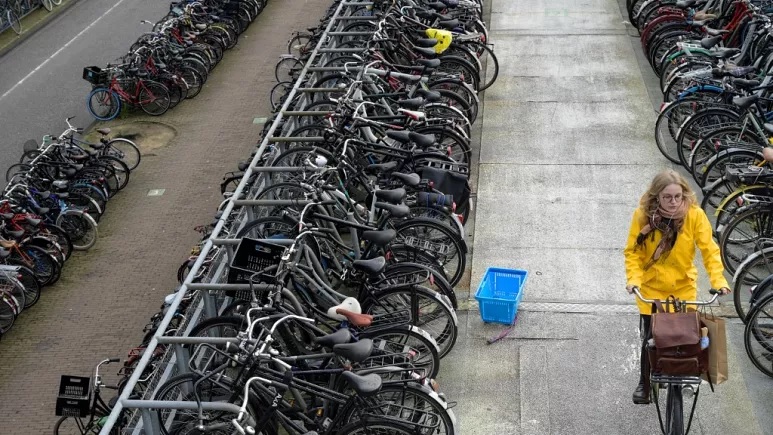Cycling varies widely among European countries, with the Netherlands and the Nordics leading the way. The number of people who never cycle is surprisingly high.
Active mobility is one of the significant ways to save energy. Not only do you save energy, but you also boost your physical and mental health by walking or cycling.
This is why the European Commission is actively calling on you to “use your own energy”.
Bicycle use is already very popular in some European countries, such as the Netherlands and Denmark. Cycling also has a significant share among the main modes of transport in some of these countries.
How often do Europeans cycle? Which countries cycle the most and least in Europe? Which cities are the most bicycle-friendly?
Several surveys that include different questions have addressed this topic, and some indexes comparing countries and cities are also available. From these, we are able to glean different insights into cycling culture in Europe.
Privately owned bikes or scooters as the main mode of transport
In 2019, 8% of EU citizens said that their main mode of transport on a typical day was a privately-owned bike or scooter (including electric ones), according to a Eurobarometer survey.
In the Netherlands, 41% of Dutch participants reported that a bike or scooter was their main mode of transport. This high rate makes the Netherlands an outlier, followed by Sweden (21%) and Germany (15%).
Only seven countries had higher shares of bicycle and scooter use than the EU average. The others were Hungary (14%), Finland (13%), and Denmark and Belgium (both 12%).
The share of bicycles or scooters as the main modes of transport was zero in Portugal and Cyprus. This figure was 2% in the UK and 3% in France.
The Mediterranean countries generally had lower shares, whereas the Nordic EU member states had higher rates of cycling, according to this metric.
The Mediterranean versus Nordic countries: How often do you cycle?
Another Eurobarometer survey conducted in 2013 asked how often people in Europe cycled. In the EU, 29% reported that they cycled at least once a week. This ranged from 3% in Malta to 71% in the Netherlands.
The patterns in the Mediterranean and Nordic countries were again similar with this metric.
Top country the Netherlands was followed by Finland (57%) and Denmark (56%) in terms of individuals cycling at least once a week. This figure was 42% in Sweden.
Hungary, Germany, and Poland reported rates of bicycle use above 40%. Four out of 10 people in both Austria and Slovakia also said they cycled at least once a week.
While 18% of respondents in France said that they cycled at least once a week, 14% did in the UK, ranking 24th out of 28 countries.
Malta (3%) had the lowest rate of weekly cyclists, followed by Cyprus (10%) and Greece (12%).
Share of people never cycling is striking
Looking at the survey more closely, half of the respondents in the EU said that they never cycled. These results were striking. In some countries, more than 70% of individuals never cycled.
In Malta, 93% responded that they never cycled, followed by other Mediterranean countries including Cyprus (82%), Portugal and Greece (both 75%) and Spain (73%).
This rate was 69% the UK and Bulgaria. Not surprisingly, it was lowest in the Netherlands (13%), followed by the three Nordic countries at about 20%.
Regular cyclists are very common in the Netherlands
In the Netherlands, approximately four out of 10 respondents (43%) daily. This compared to roughly three in 10 respondents in Denmark (30%) and Finland (28%) who also cycled daily. The EU average was 12%.
Only 5% of participants in France said they cycled daily, and 4% in the UK.
Cycling is the main mode of transport for half of Copenhageners
The modal split of passenger transport describes the relative share of each mode of transport, such as by road or rail, among total transport modes.
Among EU capitals, the share of bicycle transport is by far the highest in the Danish capital Copenhagen (49%).
This figure suggests that cycling is the main mode of transport for half of Copenhageners, according to a dataset compiled by the European Cyclists’ Federation (ECF).
Cycling accounted for 35% of passenger transport in Amsterdam, the capital of the Netherlands.
Cycling’s modal share was 9% or above in Helsinki, Berlin, Ljubljana, Zagreb, Dublin, and Stockholm.
As the results of different data collection methods and years can vary considerably, the ECF calls for careful attention in efforts to directly compare cities.
Europe dominates among bicycle-friendly cities in the world
The Copenhagenize Index gives cities points for their efforts towards re-establishing the bicycle as a feasible, accepted and practical form of transport.
Over 600 cities with over 600,000 inhabitants from all parts of the world were assessed for the 2019 index. Three-quarters of the top 20 cities are in Europe.
Copenhagen leads the list with a score of more than 90, closely followed by Amsterdam (89.3) and Utrecht (88.4).
France has three cities in the top 10. They are Strasbourg, Bordeaux and Paris. Three German cities are also in the top 20: Bremen, Berlin and Hamburg.
Source : Euronews


